- ECB opts for a ‘lower-for-longer’ QE extension in 2018 and leaves forward guidance unchanged as we expected.
- ECB will publish details on reinvestment from November 2017 onwards.
- EUR/USD range bound for now, but the ‘smell of exit’ could bring cross back to the 1.20s in 2018.
- Continued support for peripheral-core EU spreads and Scandi covered bonds.
In line with our expectation, the ECB today announced an extension of its QE programme until September 2018, but also scaled down its asset purchases to EUR30bn from January 2018 onwards (see Chart 1). Importantly, the ECB also left its forward guidance unchanged and retained the possibility to extend the QE programme in size and/or duration, leaving it open-ended. The ECB reiterated that policy rates will remain at their current levels for an extended period of time and well past the horizon of asset purchases. During the press conference Draghi clarified that no changes in the QE parameters and the sequencing on interest rates were discussed at today’s meeting.
The ECB’s QE scale down decision reflected growing confidence by the Governing Council that inflation will eventually converge to target based on an increasingly robust and broad-based economic expansion in the eurozone, an uptick in measures of underlying inflation and continued favourable financing conditions due to accommodative monetary policy measures. Nevertheless, inflation pressures remain muted and hence the ECB stressed the continued need for monetary support through the net QE purchases, forward guidance on interest rates and forthcoming reinvestments.
The introductory statement now also excluded any reference to the risks from exchange rate volatility, which is, however, not so surprising given that the effective euro appreciation pace has abated significantly since September, which we think matters more for the ECB than the exchange rate level as such
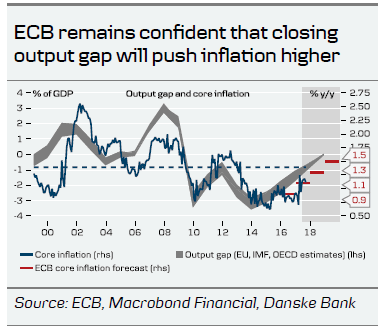
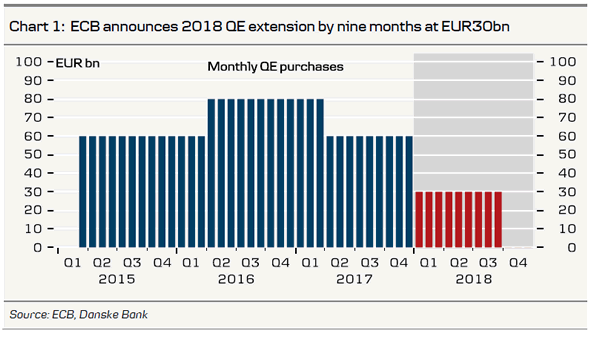
ECB releases more details on QE reinvestments in 2018
The ECB also released further details on the reinvestments of maturing bonds which are made alongside new QE purchases and which will become increasingly sizable over the course of 2018.
1. Time horizon: Reinvestments will be made ‘for an extended period of time’ after the end of the net QE purchases and ‘for as long as necessary’.
2. Composition: From 6 November 2017 the ECB will also now publish the expected monthly redemption amounts for the QE programme over a rolling 12-month horizon as well as historical redemption figures since the start of QE. The data will provide redemptions information for each of the four components (PSPP, CSPP, CBPP3 and ABSPP), but not reveal the individual country breakdown.
3. Timing: Reinvestments will be flexible and made in the month they fall due or otherwise in the subsequent two months, if warranted by liquidity conditions.
4. No change in country composition for now: Reinvestments will be made in the jurisdiction in which the maturing bonds were issued, during the period of net asset purchases.
Overall, we think the ECB’s communication will increasingly focus on the reinvestments and the stock rather than the flow of QE purchases in the future, as it gradually scales back monetary stimulus over the coming years.
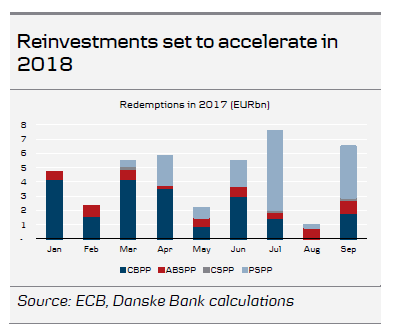
FX: EUR/USD range bound now – ‘smell of exit’ to bring back 1.20s 2018
With the ECB’s QE scheme extended as widely expected and the forward guidance essentially unchanged, little has materially changed for the single currency. But the drop in EUR/USD on the initial policy statement clearly suggests that some expectations in the FX markets had been building ahead of the meeting that the ECB could go with a more hawkish taper as price action earlier in the week is indeed testament to.
In our view, while today’s policy message underpins that the ECB is taking tapering to the next level, the continued commitment to stay accommodative on a still data-dependent basis suggests a firm move in EUR/USD above 1.20 is not on the cards until 2018, as the ECB seems very wary of taking exit talk too far at the current stage.
The longer period of QE purchases notably ensures that rate hike expectations will be kept at bay, meaning that relative rates are unlikely to provide significant support to the euro in the near term. As such, e.g. the 2Y swap spread is unlikely to drag EUR/USD higher on, say, a 3M horizon. However, we still argue that the potential for notably debt outflows to fade should support the single currency more broadly as a continued taper cements the sense that has grabbed notably the FX market that ECB normalisation is ongoing. Thus, we continue to see risks to EUR/USD being to the upside in 2018 and still target 1.25 in 12M.
Overall, the dovish tapering message from the ECB today cements our sense that EUR/USD is range bound (1.19-1.16) on a 1-3M horizon with risks tilted a tad to the downside near term. Notably, if Trump goes with Taylor as Fed chair, this opens for a move below the 1.1700 mark; we still see good support at the 1.1670 level (6 Oct low) though. In the coming days, we would expect EUR/USD to settle around the 1.1750 level with the risk of next week’s FOMC meeting fuelling a move towards 1.1700 as focus returns to Fed’s determinedness to ‘normalise’. On the upside, we think resistance at 1.1910 (2-Aug high) will hold, but in order to revisit the 1.20s we would likely need to see better prospects of eurozone core inflation edging higher on a sustained basis (a mid-2018 story) and/or markets to speculate (again) that the ECB is running into toolbox constraints
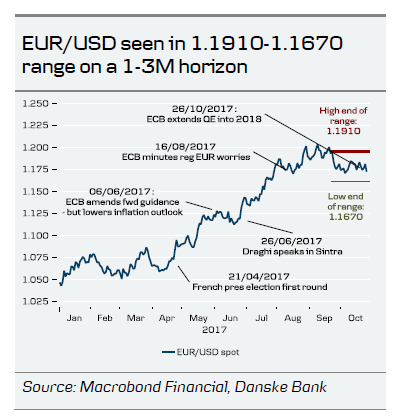
Fixed income: very supportive for the periphery and Bund spread
The statement from the ECB is very supportive for the European government bond markets both outright and relative to swaps. The combination of the extending of QE into 2018 as well as reinvesting the redemptions for an extended period of time after the QE ends is very supportive for the periphery. Finally, the MRO and the 3mth TLRO are set to continue with full allotment and a fixed rate until at least 2019. The combination of a dovish ECB, less supply in 2018 and a positive rating cycle for the EU countries is very supportive for the peripheral-core EU spreads. If we look at the combination of issuance, redemptions/reinvestments and QE, then there will still be a negative supply of European government bonds in 2018, as shown in the table below. However, the negative net supply is set to be substantially lower than the negative net supply from 2017 as shown below.
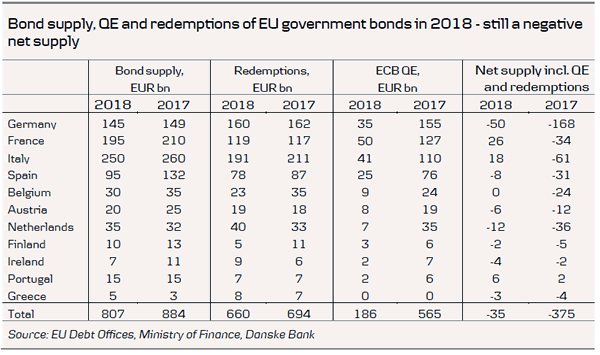
Germany still stands out with a very negative net supply in 2018. This is partly due to the surplus on the public finances as well as the QE. We have assumed a reduction in the QE amount in Germany in 2018 as the ECB/Bundesbank is close to the 33% issuer limit. Hence, the ECB/Bundesbank is set to buy well below the capital key in Germany. In total, we expect that the ECB will buy EUR186bn in the PSPP programme or 70% of the total QE in 2018. This is a substantial reduction in the PSPP programme, which as currently 85% of the total QE programme. This leaves 30% to the covered bond, ABS and corporate bond programme. We still consider it likely that the ECB will buy a higher share of corporate bonds due to the more direct economic impact, although this will probably only be revealed by the QE details in coming months.
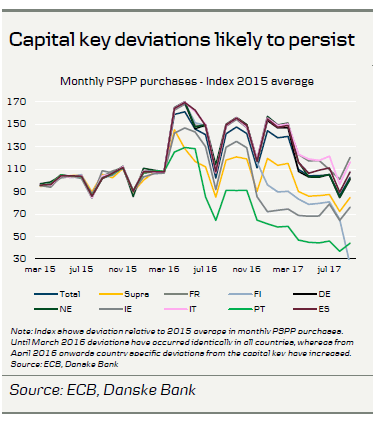
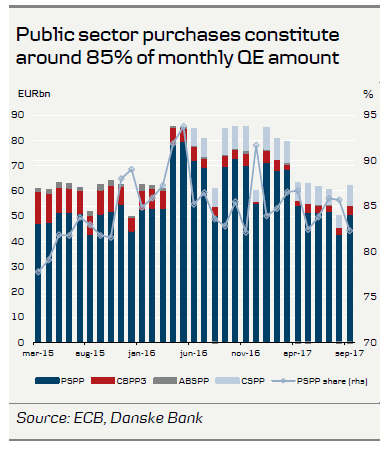
Investment conclusions for EU government bonds
There is negative supply in Germany, while the political uncertainty/problems in Spain seem to be fading. The reduction in the QE programme for e.g. Portugal, Ireland and Finland is likely to have a modest impact, as the ECB is already buying well below the capital key Hence, we see the following trades/targets for some of the trades we have or had on in 2017 and going into 2018:
1. Bund spread widener: target 55bp 2. Long 10Y PGB versus 10Y BTPS. Target 0bp 3. Long 10Y Ireland versus 10Y France. Target 0bp 4. Long 10Y Spain versus 10Y Germany. Target 100bp
If we look at the slope of the curve, then the action today from the ECB should give room for flattening of the curves as it confirms the “low for long” policy. Furthermore, if the economic outlook becomes “less favourable”, then the ECB is ready to scale on the QE etc. Hence, we could see a flattening of the 10-30Y curve, partly because of the ECB and partly because of a substantial reduction in the funding need of the EFSF/ESM in 2018. The funding need for EFSF is reduced from EUR49bn to EUR22bn.
In Fixed Income Strategy: Buy 2W10Y ATMF EUR payer ahead of next week’s ECB meeting, 26 October 2017, we recommended to buy a 2W10Y ATMF EUR payer swaption. In our view, the low implied volatility offered an attractive short-term hedge against any hawkish ‘twist’ from ECB. Although, the option maturity still covers the eurozone October CPI data releases, we take a 2bp profit on the back of yesterday’s dovish stance from the ECB.
Impact on the Scandinavian markets – Buy Scandi covered bonds
The ‘dovish’ ECB and the extension of the QE has an impact on the Scandinavian markets as the ECB continues to limit volatility in the market. Furthermore, the extension of the QE in the covered bond market will still be a drag on liquidity even though the QE is scaled down to EUR30bn. However, as the PSPP programme is scaled down more than the CBPP3, ABSPP and CSPP programmes, then the ECB will still be in the market.
Low volatility, plenty of excess liquidity and ‘low for long’ monetary policy is very positive for the Danish covered bond market, especially the Danish callable mortgage bonds. Given that the Riksbank is on hold, then given the steepness of the Swedish yield curves (govt, covered bond and swap curves) relative to Euroland, combined with the yield pick-up from an FX-hedge into euros, then both 30Y Danish callable mortgage bonds as well as 5Y Swedish covered bonds are attractive alternatives to EU peers. But although today’s ECB decision should be supportive for SEK covered bonds in isolation, uncertainty about the housing market might pose some risk since the knee-jerk reaction to a deteriorating situation in the housing market would not be in favour of the bonds (at least not relative to swaps or SGBs).













